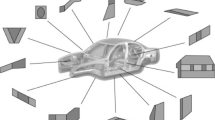Abstract
TIMETAL LCB was introduced more than 10 years ago targeting automotive suspension spring applications. The alloy development aim was to use a low-cost formulation by selecting less expensive raw materials than typical beta titanium alloys. Following the first successful application ofTIMETAL LCB suspension springs to series production vehicles, the 2000 Volkswagen Lupo FSI, the springs have been used for Ferrari Challenge Stradale since 2003. The most recent development effort was focused on the generation of metallurgical and mechanical service data for the alloy, and the implementation of efficient low cost processing of coils. This paper will introduce various properties ofTIMETAL LCB products that can be useful in the design and the consideration of spring applications. Recent progress in the processing ofTIMETAL LCB will also be introduced and discussed.
Similar content being viewed by others
References
P.G. Allen, P.J. Bania, A.J. Hutt, and Y. Combres, A Low Cost Beta Alloy for Automotive and Other Industrial Applications,Titanium ’95 Science and Technology, P.A. Blenkinsop, W.J. Evans, and H.M. Flower, Ed., The Institute of Metals, 1995, p 1680–1687
O. Schauerte, D. Metzner, R. Krafzig, K. Bennewitz, and A. Kleemann, Fahrzeugfedern Federleicht—Erster Serieneinsats einer Achesschraubenfeder aus Titan,ATZ Automobiltechn. Z., Vol 103, 2001, p 654–660 (in German)
K. Faller, Titanium Springs Make Production Car Debut,Spring Technol., Vol 40 (No. 4), 2001, p 25–27
J. Kiese, W. Walz, and B. Skrotzki, Influence of Heat Treatment and Shot Peening on Fatigue Behavior of Suspension Springs Made ofTIMETAL LCB,Ti2003 Science and Technology, G. Lutjering and J. Albrecht, Ed., Wiley-VCH Verlag GmbH & Co., 2004, p 3043–3050
P.G. Allen and A.J. Hutt, Low Cost Beta Automotive Applications,Proceedings 1994 International Titanium Conference, Coronado, CA, ITA, 1994, p 179–188
S.P. Fox and Y. Kosaka, Titanium Suspension Springs—An Update,SAE Technical Paper Series, No. 02M-96, Society of Automotive Engineers, 2002
Y. Kosaka and S.P. Fox, Recent Developments in the Manufacturing of Low Cost Titanium Alloys,High Performance Metallic Materials for Cost Sensitive Applications, F.H. Froes, E.Y. Chen, R.R. Boyer, E.M. Taleff, L. Lu, F.L. Zhang, C.M. Ward-Close, and D. Eliezer, Ed., TMS, 2002, p 35–42
Y. Kosaka, Properties ofTIMETAL LCB for Automotive Suspension Spring Applications,Titanium Jpn., Vol 52, 2004, p 1–6 (in Japanese)
Y. Kosaka and S.P. Fox, Properties and Production Experiences ofTIMETAL LCB for Automotive Spring Applications,SAE Technical Paper Series, No. 2003-01-1181, Society of Automotive Engineers, 2003
Y. Kosaka, S.P. Fox, K. Faller, and S.H. Reichman, Low Cost Processes for Automotive Titanium Materials,Cost Affordable Titanium, F.H. Froes, M.A. Inam, and D. Fray, Ed., TMS, 2004, p 77–84
Author information
Authors and Affiliations
Rights and permissions
About this article
Cite this article
Kosaka, Y., Fox, S.P., Faller, K. et al. Properties and processing ofTIMETAL LCB. J. of Materi Eng and Perform 14, 792–798 (2005). https://doi.org/10.1361/105994905X75637
Received:
Published:
Issue Date:
DOI: https://doi.org/10.1361/105994905X75637




